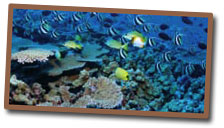|
Protection and Management
Papahānaumokuākea Marine National Monument Declared a Particularly Sensitive Sea Area
 The vast marine ecosystems of the Northwestern Hawaiian Islands encompassed by the Papahānaumokuākea Marine National Monument received additional protection under a new, internationally recognized designation on April 4, 2008. The International Maritime Organization declared the waters of the monument a "Particularly Sensitive Sea Area" (PSSA) - a designation that includes measures to protect marine resources of ecological and cultural significance from damage by ships while helping keep mariners safe. Under the PSSA designation, a ship reporting system was implemented and special zones in the monument known as "areas to be avoided" were added to international nautical charts to direct ships away from coral reefs, shipwrecks and other sensitive areas that may pose a navigation hazard. The monument is the world's 11th marine protected area to receive PSSA designation, joining special places like Florida Keys National Marine Sanctuary, the Great Barrier Reef, and the Galapagos Archipelago. Click here for more information. The vast marine ecosystems of the Northwestern Hawaiian Islands encompassed by the Papahānaumokuākea Marine National Monument received additional protection under a new, internationally recognized designation on April 4, 2008. The International Maritime Organization declared the waters of the monument a "Particularly Sensitive Sea Area" (PSSA) - a designation that includes measures to protect marine resources of ecological and cultural significance from damage by ships while helping keep mariners safe. Under the PSSA designation, a ship reporting system was implemented and special zones in the monument known as "areas to be avoided" were added to international nautical charts to direct ships away from coral reefs, shipwrecks and other sensitive areas that may pose a navigation hazard. The monument is the world's 11th marine protected area to receive PSSA designation, joining special places like Florida Keys National Marine Sanctuary, the Great Barrier Reef, and the Galapagos Archipelago. Click here for more information.
Florida Keys Sanctuary Releases Revised Management Plan Following Extensive Public Process
In December 2007, Florida Keys National Marine Sanctuary released its revised management plan, the result of six years of rigorous review and public involvement. The sanctuary's management plan is designed to identify the best strategies to protect the natural and cultural resources the Florida Keys, and the sanctuary is mandated by Congress to review the plan every five years to assess its effectiveness. When the Florida Keys sanctuary's first management plan was under development in the 1990s, it received more than 6,000 comments from the public. The 2007 revised plan, which also solicited comments at public meetings and via the Federal Register, received only a few dozen comments - proof that the extensive public involvement throughout the creation of the original plan succeeded. The revised plan contains four new action plans addressing science management and administration, damage assessment and restoration, operations, and evaluation. Click here for more information.
Gulf of the Farallones National Marine Sanctuary Releases Plan to Restore Bolinas Lagoon
Following a year of formal meetings and workshops, in July 2008 the Farallones sanctuary released the widely anticipated Bolinas Lagoon Restoration Plan, which outlines a strategy to restore the health of this 1,100-acre tidal estuary. The lagoon, which is a Ramsar-recognized wetland site of international importance, provides critical habitat for several endangered species. After over a decade of controversy and debate, residents, scientists, federal and state officials and environmental groups adopted the science-based plan to restore it from past human impacts. Actions recommended by the plan include removing silt that is encroaching into the lagoon, removing non-native plants that hinder the natural movement of sediments and water flow, and redesigning roads that choke or block the flow of streams. Click here for more information.
R/V Manta Dedicated at Flower Garden Banks National Marine Sanctuary
In June 2008, Flower Garden Banks National Marine Sanctuary commissioned a new, custom-designed research vessel, the R/V Manta. Designed with flexibility in mind, the Manta's ability to adapt to the goals of a project make it a valuable tool for the sanctuary and its partners. The vessel greatly enhances the staff's ability to respond to natural events such as hurricanes, coral diseases and coral bleaching, as well as human disturbances such as oil spills, anchoring and illegal fishing activities. The Manta will also be used for education and outreach activities, including professional development workshops. The vessel leverages the resources of many partners in the Gulf of Mexico region, including other government agencies, academia and non-profit organizations. The Manta has already proven to be an asset to the local community by providing support to emergency response and recovery teams immediately following Hurricane Ike. Click here for more information.
|



